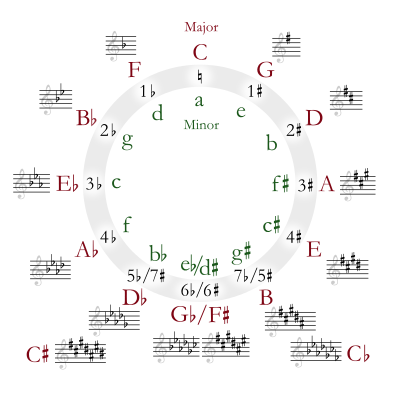F-sharp minor
 | |
| Relative key | A major |
|---|---|
| Parallel key |
F♯ major enharmonic: G♭ major |
| Dominant key | C♯ minor |
| Subdominant | B minor |
| Component pitches | |
| F♯, G♯, A, B, C♯, D, E, F♯ | |
F-sharp minor is a minor scale based on F-sharp, consisting of the pitches F♯, G♯, A, B, C♯, D, and E. For the harmonic minor, the E is raised to E♯. Its key signature has three sharps.
Its relative major is A major, and its parallel major is F♯ major (or enharmonically G♭ major).
Changes needed for the melodic and harmonic versions of the scale are written in with accidentals as necessary.
Very few symphonies are written in this key, Haydn's Farewell Symphony being one famous example. George Frederick Bristow and Dora Pejačević also wrote symphonies in this key.
The few concerti written in this key are usually written for the composer himself to play, including Rachmaninoff's Piano Concerto No. 1, Scriabin's Piano Concerto, Wieniawski's Violin Concerto No. 1, Vieuxtemps's Violin Concerto No. 2, and Koussevitzky's Double Bass Concerto.
In addition to the Farewell Symphony, Haydn's Piano Trio No. 40 (Hob. XV:26) and String Quartet Op. 50, No. 4 are in F-sharp minor.
Handel set the sixth of his eight harpsichord suites of 1720 in F-sharp minor. Aside from a prelude and fugue from each of the two books of Das Wohltemperierte Klavier, Bach's only other work in F-sharp minor is the Toccata BWV 910. Mozart's only composition in this key is the second movement to his Piano Concerto No. 23 in A major.[1]
Notable classical compositions in F-sharp minor
- George Frideric Handel - Suite de pièces Vol. 1 No. 6, HWV 431
- Ludwig van Beethoven - Piano Sonata No.29 'Hammerklavier' Adagio Sostenuto (Third Movement)
- Johannes Brahms – Piano Sonata No. 2, Op. 2
- Joseph Haydn – Symphony No. 45, Farewell Symphony
- Frédéric Chopin – Polonaise in F-sharp minor, Op. 44
- Chopin – Nocturne, Op. 48, No. 2
- Chopin – Mazurka No. 3, Op. 59
- François Couperin - Ordre 26ème de clavecin in F-sharp minor
- Ernő Dohnányi: Suite in F-sharp minor
- Gabriel Fauré – Pavane, Op. 50
- Sergei Rachmaninoff – Piano Concerto No. 1, Op. 1
- Rachmaninoff – Prelude in F-sharp minor No. 1, Op. 23
- Franz Schubert - Piano Sonata in F-sharp minor, D 571 (incomplete)
- Robert Schumann - Piano Sonata No. 1, Op. 11
- Alexander Scriabin – Piano Concerto, Op. 20
- Dmitri Shostakovich – Prelude and Fugue No. 8, Op. 87
- Georg Philipp Telemann – Fantasy for Solo Flute No. 10
- Henryk Wieniawski – Violin Concerto No. 1, Op. 14
References
- ↑ p. 30 Hopkins London (1964) n. 1 Anthony Talking About Concertos Heinemann
- A. Morris, "Symphonies, Numbers And Keys" in Bob's Poetry Magazine, III.3, 2006.
External links
 Media related to F-sharp minor at Wikimedia Commons
Media related to F-sharp minor at Wikimedia Commons
| Diatonic scales and keys | |||||||||||||||||||||||||||||||||||||||||||||||||||||||
|---|---|---|---|---|---|---|---|---|---|---|---|---|---|---|---|---|---|---|---|---|---|---|---|---|---|---|---|---|---|---|---|---|---|---|---|---|---|---|---|---|---|---|---|---|---|---|---|---|---|---|---|---|---|---|---|
 |
| ||||||||||||||||||||||||||||||||||||||||||||||||||||||
| The table indicates the number of sharps or flats in each scale. Minor scales are written in lower case. | |||||||||||||||||||||||||||||||||||||||||||||||||||||||